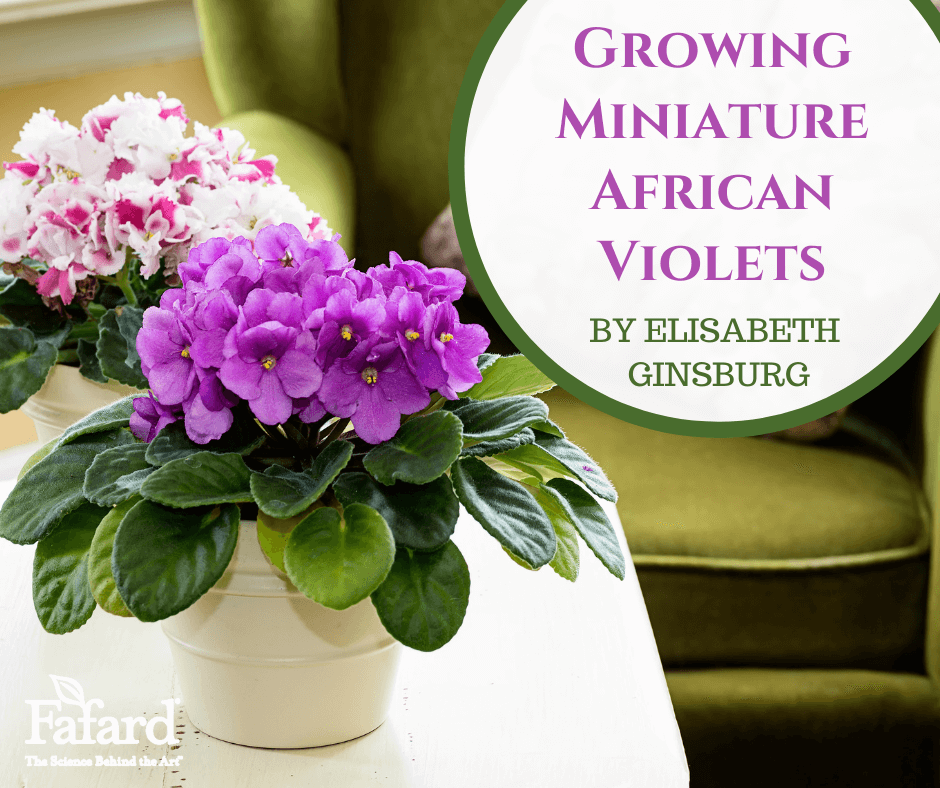
Miniature African violet (Saintpaulia ionantha hybrids), look and act very much like their larger violet siblings. The big difference is the small size. Minis feature a basal leaf rosette that is only 3 to 6 inches in diameter, making them perfect for limited growing space, terrariums and other special situations.
African Violet History

African violets are not true violets, but members of the Gesneriaceae family. Their wild ancestors were first collected in 1892 from forests in what is now Tanzania by Baron Walter St. Paul, a German colonial official, and amateur botanist. St. Paul sent the specimens to his father in Germany, who passed them on to Hermann Wendland, Director of the Royal Botanical Garden, who first described them. Eventually, the new genus was christened Saintpaulia, after Baron St. Paul. The species name, “ionantha” means “violet-like,” in honor of the purple flowers.
The violets arrived in New York in 1894. They caught on with plant lovers and by 1946, they were so popular that a group of enthusiasts formed the African Violet Society of America (AVSA). The society, which is also the registration authority for new violet varieties, now describes itself as “the largest society devoted to a single indoor plant in the world.”

African Violet Sizes
As the vogue for African violets grew, breeders created new varieties, expanding the range of flower and leaf forms and colors, as well as plant sizes. Miniatures are one of a handful of recognized size categories. The others are micro-miniatures (less than 3 inches in diameter), semi-miniatures (6 to 8 inches), standard (8 to 16 inches) and large (over 16 inches). Minis, micro-minis, and semi-minis are genetically predisposed to small size, but may occasionally grow larger than the dimensions that define their categories.
African Violet Flowers and Leaves
Like their larger relatives, minis may have single, semi-double or double flowers. Traditional single flowered varieties feature five petals, with the two on top slightly smaller than the bottom three. Petal size is more uniform on varieties with single, star-shaped flowers. Petal edges can be flat, slightly wavy or exuberantly ruffled. Color possibilities include shades of white, pale green, pink, red, yellow, purple and blue-purple, as well as combinations of those colors.
Miniature African violet leaves are sometimes as interesting as the flowers, with variations in shape, size, texture, leaf edges and color. Some varieties bear bi-colored foliage with contrasting variegation in shades of green, tan or cream.

Miniature African Violet Care
Beautiful minis need loving care. This starts with a free-draining, soilless potting medium like Fafard African Violet Potting Mix. Good drainage is essential to violet health because too much moisture causes deadly crown rot. Once potted up, minis should be watered whenever the surface of the soil feels dry to the touch. Feed the plants each time you water with a diluted solution of balanced fertilizer (for example 20-20-20), following manufacturers’ directions, or using one 1/8 teaspoon fertilizer per gallon of water. If you water from the top, avoid the leaves, as water droplets cause unsightly leaf spotting. Water from the bottom by filling the saucer and allowing the plant to stand for an hour before emptying out the remaining water.
Indoors, minis need bright, indirect light from east or west-facing windows. South-facing windows may also provide good light in the winter but need to be covered with sheer curtains in summer to prevent leaf burn. Promote balanced growth by turning the plants about 90 degrees each time they are watered. Plants may also vacation outdoors during the growing season, as long as they are positioned in light shade.
Grooming African Violets
Groom miniature African violets by removing dead or dying leaves. To promote flowering and maintain the plants at the optimum size, do not allow them to produce more than five horizontal rows of leaves. Rejuvenate overgrown specimens by removing the lowest row(s) of leaves and repot, if necessary, using fresh potting mix. Minis and other African violets flower best when they are somewhat pot-bound.
For more information on minis and other African violets, contact the African Violet Society of America, 2375 North Street, Beaumont, TX 77702-1722, (409) 839-4725.

